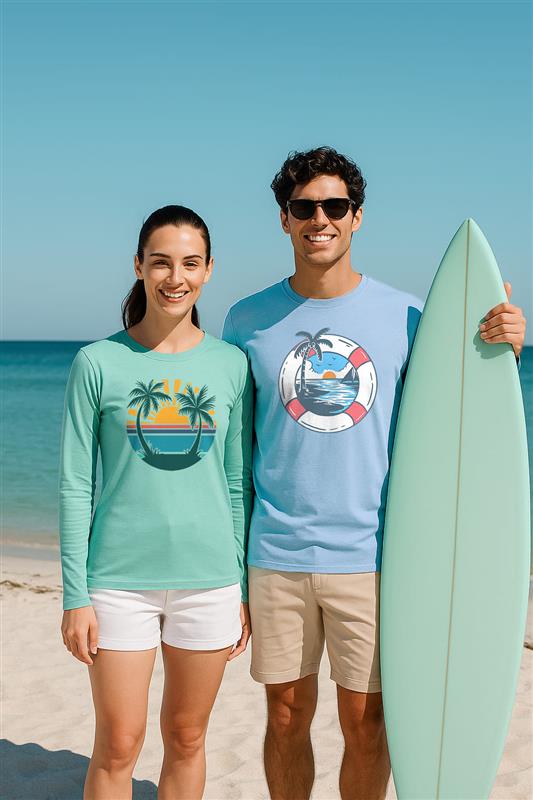Best Hiking Apparel For Any Terrain And Every Season

Selecting proper hiking clothes for any surface matters to keep you safe and cozy. The suitable equipment can face heat, snow, rain, or rock trail, drying you and covering you wherever you wander. Most hikers make things difficult because they select attire not suitable for conditions or they even forget to include necessary layers.
You can hike further and feel better if you know what to wear. This blog post will give you basic tips on how to pick the right hiking clothes for any kind of terrain. You will also discover how to avoid common mistakes hikers make when selecting clothing.
Key Takeaways
-
Good hiking clothes match the terrain and climate.
-
The proper equipment safeguards you and increases comfort.
-
Avoid common mistakes by planning what you wear.
Why Proper Hiking Attire Matters?
When trekking, you have to prepare yourself for any surface and changing weather patterns. Adequate dressing keeps you comfortable and safe. Adequate dressing enables you to walk comfortably, stay dry, and warm or cool as required.
Imposing inappropriate dress is likely to trigger problems like chills, heat, or blisters. Your attire can also make you wet due to rain or sweat excessively if it is not well ventilated.
If your clothes hold on to sweat, then your skin may become infected or inflamed. But if your layers keep moisture away, you stay comfortable and dry.
The best hiking apparel for any terrain also protects you from surprises. A sudden storm won't be so terrible if you possess a waterproof jacket. Hiking clothing assists you in coping with rocky trails, muddy terrain, or dense forest easily.
Things That Should Be Considered Carefully When Choosing Hiking Equipment
The appropriate hiking attire will shield you from insects, rain, cold weather, sun, and injury. Good-quality equipment also facilitates easier mobility and ensures comfort throughout the journey.
Terrain Type
Various terrain calls for various equipment. Wear clothing that will not tear easily when you are on rocky or uneven ground to shield your skin from sharp rocks or branches. In forests, long pants and sleeves are required to shield you from cuts, poison ivy, and ticks.
Mountain climbing requires clothing that will hold up under temperature fluctuations and maybe powerful winds. If you're stranded in the desert, wear light, airy clothing to prevent sunburn and heatstroke.
Weather Conditions
Wear weather gear appropriately wherever you hike. On warmer days, moisture-wicking and ventilated shirts keep sweat away so you won't feel sticky or overheat. Light-colored colors reflect the sunlight. When rain is predicted, bring a waterproof jacket and select pants that dry quickly. Cold weather requires layers. Begin with a base layer that keeps sweat off your skin, followed by a warm layer such as fleece or down.
Fabric Choice
Cotton absorbs sweat and dries slowly. This can leave you cold. Synthetic fibers like polyester, nylon, or merino wool are its better substitutes. These will warm you up and prevent you from chafing by drying off fast and keeping sweat away from your skin. Wool does not smell and insulates you even when wet.
|
Fabric Type |
Pros |
Cons |
|
Polyester/Nylon |
Lightweight, dries fast |
Can hold odors after many wears |
|
Merino Wool |
Warm, odor-resistant |
Costs more than synthetic fabrics |
|
Cotton |
Soft, cheap |
Holds moisture, dries very slowly |
Fit And Mobility
Choose clothes that fit well but are not tight. You should be able to move your arms and legs freely to climb or step over rocks. Pants should allow easy movement but not drag on the ground. Shirts should cover your waist, even when you raise your arms, to avoid sunburn or bug bites.
Essential Hiking Clothing For All Conditions
Staying comfortable outdoors means choosing the right clothes for your hike. You need smart layers to keep you dry, warm, and protected, no matter the weather or trail.
Base Layers And Underwear
Start with a good base layer. This is the first clothing item that touches your skin. Look for materials like synthetic fibers or merino wool. These wick sweat away and help you stay dry, even as you sweat.
Do not wear cotton base layers. Cotton holds moisture, which can make you cold or even cause chafing. Choose long-sleeve or short-sleeve styles based on the weather and sun exposure.
For underwear, stick to seamless or flat-seamed designs. This helps prevent rubbing. Many hikers prefer synthetic briefs or merino wool for comfort.
Insulating Mid Layers
The mid-layer adds warmth. Common choices are fleece jackets, lightweight down jackets, or thick synthetic pullovers. These trap heat but let some sweat escape.
Fleece is a popular option. It keeps you warm even if it gets wet and is easy to pack. Down jackets are very light and warm but can lose insulation if soaked. If you expect rain, use a synthetic puffy jacket instead.
A good mid-layer should fit over your base layer and under your jacket. Choose an easy layer to put on or remove as temperatures change.
|
Type |
Warmth |
Weight |
Water Resistance |
|
Fleece |
Good |
Light |
Fair |
|
Synthetic Puffy |
Great |
Light |
Good |
|
Down Jacket |
Great |
Very light |
Poor |
Weatherproof Outerwear
Your final layer is for wind, rain, or snow. A waterproof and breathable jacket (sometimes called a "shell") protects you from storms and wind.
Look for jackets made with Gore-Tex or similar membranes. These let sweat out but block water from getting in. Ensure the seams are taped, and the zippers have covers or water guards.
For pants, choose lightweight rain pants that pack down small. Waterproof mittens and hats can also help protect you in cold or wet climates.
Footwear And Accessories For Every Terrain
Sturdy footwear and accessories can prevent injuries and make your hike more comfortable. Protect your feet with proper boots and socks, and stay shielded from the elements with accessories for your head, hands, and ankles.
Hiking Boots And Shoes
Your feet will have the most effect on any trail. Choose footwear with a hard sole and strong ankle support for rocky or uneven terrain. Trails that are level or clearly signposted are ideal for lightweight hiking shoes.
In damp conditions, your feet are dried with a water-repellent material. Good tread gives you traction, especially on muddy or loose trails. When trying on boots, always wear the socks you plan to wear with them.
Socks For Protection And Comfort
Even though they look plain, socks play a crucial role in keeping your feet healthy. Select fabrics that can wick away moisture, such as synthetic blends or merino wool. These materials keep your feet dry and thus avoid blisters and odor. Don't use cotton socks since they retain moisture and cause friction.
|
Material |
Pros |
Cons |
|
Wool |
Warm, wicks moisture, soft |
Can be pricey |
|
Synthetic |
Dries fast, durable |
Less warmth |
|
Cotton |
Cheap, soft |
Holds moisture |
Hats, Gloves, And Gaiters
Hats keep your head safe from sun and cold. On sunny days, a wide-brimmed hat keeps the face and neck covered. A beanie or a knit cap keeps the body warm in winter. Adjustable straps or drawstrings hold hats on windy days.
Gloves prevent your hands from freezing and blistering if you're trekking with poles. Thin gloves work well in freezing temperatures, but insulated gloves work well in icy conditions. Touchscreen fingertips are on some gloves, so you can use your phone without taking your hand off it.
Gaiters are fitted at the top of your lower legs and boots. They prevent dirt, water, and pebbles from getting in on muddy or stony trails. Waterproof gaiters are essential if you're expecting river crossings or heavy rain.
What Are Typical Blunders Hikers Commit When Picking Clothes?
-
Cotton is what most hikers use. Cotton is moist and does not dry out easily, and wet cotton feels cold and heavy.
-
Getting the wrong size is also frequent. Too-tight or too-loose clothing may limit movement or chafe. Proper hiking gear should fit well on your body.
-
Another mistake is ignoring the weather. Some people do not bring a rain jacket or enough layers for colder temperatures. You always need to check the forecast and pack for sudden changes.
-
Some hikers forget about footwear. Regular sneakers may not provide enough support or grip, and wearing boots that do not fit well can lead to blisters.
-
Many people skip sun protection. Not wearing a hat or forgetting sunscreen and sunglasses increases the risk of sunburn.
-
Another issue is forgetting to layer. Using just one thick jacket instead of layers can make it hard to stay comfortable.
Find Our Top Selection Of Hiking Clothing For Any Surface
Great hiking gear can make or break your trip. Whether it's sunny, rainy, or a little bit of both, you want gear that keeps you dry, cool, and comfortable. That's why we curated our top selection of hiking gear for any terrain. It's designed to withstand the trail—so you can concentrate on enjoying the ride.
Performance UV Protection Hiking Shirt
A Performance UV Protection Hiking Shirt shields your skin from the sun’s rays. It uses lightweight fabric rated UPF 50+ to block harmful UV exposure. This strong rating helps you hike for hours without worrying about sunburn.
|
Feature |
Details |
|
Sun Protection |
UPF 50+ rating blocks 98% of harmful UV rays |
|
Fabric |
Lightweight, breathable, moisture-wicking material |
|
Fit |
Relaxed fit for easy movement and airflow |
|
Use Case |
Great for sunny trails, deserts, coastal hikes |
|
Durability |
Strong stitching for active use and long hikes |
All-Season Convertible Hiking Pants
All-season convertible hiking pants offer flexibility on the trail. Their main feature is zip-off legs that turn them into shorts in warm weather. This lets you adapt in seconds without carrying extra clothes.
|
Feature |
Details |
|
Convertible Design |
Zip-off legs turn pants into shorts instantly |
|
Fabric |
Stretch material for flexibility and comfort |
|
Water Resistance |
Dries quickly and repels light rain |
|
Sun Protection |
Built-in UPF rating to protect legs from UV rays |
|
Fit & Adjustability |
Adjustable waist for a custom fit |
|
Best For |
Changing weather, multi-day hikes, warm or cool terrain |
Lightweight Waterproof Trail Jacket
A lightweight, waterproof trail jacket keeps you dry in rain or wind. It uses taped seams and a waterproof membrane to block moisture, but it also lets sweat escape so you don’t get clammy.
|
Feature |
Details |
|
Waterproof |
Taped seams, waterproof membrane |
|
Breathable |
Vents allow sweat to escape |
|
Packable |
Folds into its own pocket |
|
Adjustable Fit |
Cuffs, hem, and hood adjust to block rain |
|
Visibility |
Reflective details for low-light safety |
|
Best Use |
Rainy, windy, or mixed-weather hikes |
Frequently Asked Questions
What Gear Do You Need To Wear While Hiking On Various Terrain?
To keep the sweat from touching your skin, it's necessary that you have a base layer that will repel sweat. You can produce body heat by wearing insulating clothing like fleece. As a precaution against the weather, wear an outer layer jacket in any weather, preferably wind and waterproof. Wear strong hiking shoes and good socks on your feet too, in any location.
How Do You Follow The 3-Layer Rule For Backpacking During Unstable Weather?
Start with a foundation layer of merino wool or synthetic to avoid you from being wet. Use a middle layer, like light fleece or a down jacket, for warmth. Top it all off with a waterproof shell or jacket to seal out wind and rain. Layer up or take off layers according to temperature change.
What Are The Factors To Consider In Choosing Hiking Clothing For Women And Men?
Inspect the clothing's fit, comfort, and water/windproofing. Men and women should have air-permeable, quick-drying material. On multi-day treks, the clothing should be fully mobile and have zip pockets or vents.
How Does One Select The Proper Hiking Gear Without The Benefit Of Specialty Hiking Attire?
Select moisture-wicking sports apparel that is comfortable to move in. A quality pair of sport pants or leggings, a well-fitting T-shirt, and an ordinary rain jacket are typically enough for most short day hikes. If you do not have hiking boots, running shoes with adequate tread will suffice.


